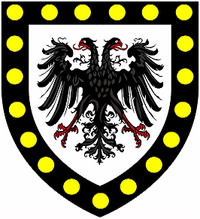Killigrew baronets

The Killigrew Baronetcy, of Arwennick in the County of Cornwall, was a title in the Baronetage of England. It was created on 22 December 1660 for William Killigrew (d.1665), 6th son of John Killigrew (c.1557-1605) of Arwenack, near Falmouth in Cornwall, thrice MP for Penryn in 1584, 1586 and 1597, and Vice-Admiral of Cornwall and like his father and grandfather was Captain of Pendennis Castle (1584–98)[1] The 1st Baronet was created a baronet at the Restoration of the Monarchy in 1660, which event was largely brought about by his uncle George Monck, 1st Duke of Albemarle (1608-1670). He died without progeny and the title by special remainder descended to his nephew Peter Killigrew, son of his elder brother Sir Peter Killigrew (1593-1667), MP for Camelford.[2] The second Baronet was Member of Parliament for Camelford. The title became extinct on his death in 1704.[3][4][5]
Killigrew baronets, of Arwennick (1660)
[edit]- Sir William Killigrew, 1st Baronet (died 1665)
- Sir Peter Killigrew, 2nd Baronet (c. 1634–1705)
References
[edit]- ^ History of Parliament biography [1]
- ^ Vivian, J.L., ed. (1887). The Visitations of Cornwall: comprising the Heralds' Visitations of 1530, 1573 & 1620; with additions by J.L. Vivian. Exeter: W. Pollard, p.269 [2]
- ^ John Burke; John Bernard Burke (1841). A Genealogical and Heraldic History of the Extinct and Dormant Baronetcies of England, Ireland and Scotland (2nd ed.). Scott, Webster, and Geary. p. 290. Retrieved 1 March 2013.
{{cite book}}: CS1 maint: multiple names: authors list (link) - ^ Hunt, Robert (1865). Popular Romances of the West of England, Or, The Drolls, Traditions and Superstitions of Old Cornwall, Volume 2. John Camden Hotten. p. 277.
- ^ Thomas, Richard (1815). A Falmouth Guide. Lake. p. 39.
